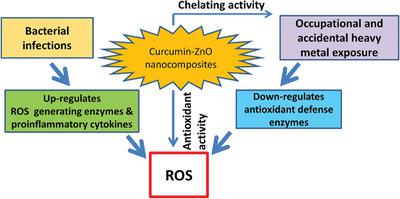当前位置:
X-MOL 学术
›
Biotechnol. Appl. Bioc.
›
论文详情
Our official English website, www.x-mol.net, welcomes your
feedback! (Note: you will need to create a separate account there.)
Conjugation of micro/nanocurcumin particles to ZnO nanoparticles changes the surface charge and hydrodynamic size thereby enhancing its antibacterial activity against Escherichia coli and Staphylococcus aureus
Biotechnology and Applied Biochemistry ( IF 3.2 ) Pub Date : 2020-06-13 , DOI: 10.1002/bab.1968 Soumitra Shome 1, 2 , Anupam Das Talukdar 2 , Sujit Tewari 3 , Sudip Choudhury 4 , Mrinal Kanti Bhattacharya 1 , Hrishikesh Upadhyaya 5
Biotechnology and Applied Biochemistry ( IF 3.2 ) Pub Date : 2020-06-13 , DOI: 10.1002/bab.1968 Soumitra Shome 1, 2 , Anupam Das Talukdar 2 , Sujit Tewari 3 , Sudip Choudhury 4 , Mrinal Kanti Bhattacharya 1 , Hrishikesh Upadhyaya 5
Affiliation

|
Nanobiotechnology-mediated synthesis of ZnO nanoparticles, micro/nanocurcumin, and curcumin–ZnO nanocomposites and their characterization followed by comparative study of their antibacterial, antioxidant, and iron-chelating efficiency at various dosages are discussed. Micro/nanocurcumin and ZnO nanoparticles were synthesized using curcumin and zinc nitrate as precursor and then conjugated by sonication to synthesize curcumin–ZnO nanocomposites. The synthesized nanoparticles were then characterized by using ultraviolet-visible spectroscopy, X-ray diffraction, Scanning electron microscopy, Fourier-transform infrared spectroscopy, and dynamic light scattering analysis. After that, the antibacterial activity of the synthesized nanoparticles was evaluated by the optical density (OD600) method against Escherichia coli and Staphylococcus aureus cells. The DPPH (2,2-diphenyl-1-picrylhydrazyl ), hydroxyl radical scavenging activity, and ferrous ion–chelating efficiency of synthesized nanoparticles were evaluated by spectrophotometry analysis. Nanocurcumin (mean zeta potential = −25 mV; average hydrodynamic diameter = 410 nm) based coating of ZnO nanoparticles (mean zeta potential = −15.9 mV; average hydrodynamic diameter = 274 nm) to synthesize curcumin–ZnO nanocomposites (mean zeta potential = −18.8 mV; average hydrodynamic diameter = 224 nm) exhibited enhanced zeta potential, which resulted in reduced agglomeration, smaller hydrodynamic size in water, improved aqueous solubility, and dispersion. All the aforesaid factors including the synergistic antibacterial effect of ZnO nanoparticle and micro/nanocurcumin contributed to increased antibacterial efficiency of curcumin–ZnO nanocomposites. Micro/nanocurcumin due to its better water solubility and small hydrodynamic diameter exhibited enhanced antioxidant and ferrous ion–chelating efficiency than curcumin.
中文翻译:

微/纳米姜黄素颗粒与 ZnO 纳米颗粒的结合改变了表面电荷和流体动力学尺寸,从而增强了其对大肠杆菌和金黄色葡萄球菌的抗菌活性
讨论了纳米生物技术介导的氧化锌纳米颗粒、微/纳米姜黄素和姜黄素-氧化锌纳米复合材料的合成及其表征,然后比较研究了它们在不同剂量下的抗菌、抗氧化和铁螯合效率。以姜黄素和硝酸锌为前驱体合成微/纳米姜黄素和氧化锌纳米颗粒,然后通过超声共轭合成姜黄素-氧化锌纳米复合材料。然后通过使用紫外-可见光谱、X 射线衍射、扫描电子显微镜、傅里叶变换红外光谱和动态光散射分析对合成的纳米粒子进行表征。之后,通过光密度(OD 600)方法评估合成的纳米颗粒的抗菌活性。大肠杆菌和金黄色葡萄球菌细胞。通过分光光度计分析评估合成纳米颗粒的 DPPH(2,2-二苯基-1-苦基肼)、羟基自由基清除活性和亚铁离子螯合效率。纳米姜黄素(平均 zeta 电位 = -25 mV;平均流体动力学直径 = 410 nm)基于 ZnO 纳米粒子涂层(平均 zeta 电位 = -15.9 mV;平均流体动力学直径 = 274 nm)以合成姜黄素-ZnO 纳米复合材料(平均 zeta 电位 = - 18.8 mV;平均流体动力学直径 = 224 nm)表现出增强的 zeta 电位,这导致团聚减少、水中的流体动力学尺寸更小、水溶性和分散性提高。所有上述因素,包括氧化锌纳米颗粒和微/纳米姜黄素的协同抗菌作用,都有助于提高姜黄素-氧化锌纳米复合材料的抗菌效率。微/纳米姜黄素由于其更好的水溶性和较小的流体动力学直径,表现出比姜黄素更高的抗氧化和亚铁离子螯合效率。
更新日期:2020-06-13
中文翻译:

微/纳米姜黄素颗粒与 ZnO 纳米颗粒的结合改变了表面电荷和流体动力学尺寸,从而增强了其对大肠杆菌和金黄色葡萄球菌的抗菌活性
讨论了纳米生物技术介导的氧化锌纳米颗粒、微/纳米姜黄素和姜黄素-氧化锌纳米复合材料的合成及其表征,然后比较研究了它们在不同剂量下的抗菌、抗氧化和铁螯合效率。以姜黄素和硝酸锌为前驱体合成微/纳米姜黄素和氧化锌纳米颗粒,然后通过超声共轭合成姜黄素-氧化锌纳米复合材料。然后通过使用紫外-可见光谱、X 射线衍射、扫描电子显微镜、傅里叶变换红外光谱和动态光散射分析对合成的纳米粒子进行表征。之后,通过光密度(OD 600)方法评估合成的纳米颗粒的抗菌活性。大肠杆菌和金黄色葡萄球菌细胞。通过分光光度计分析评估合成纳米颗粒的 DPPH(2,2-二苯基-1-苦基肼)、羟基自由基清除活性和亚铁离子螯合效率。纳米姜黄素(平均 zeta 电位 = -25 mV;平均流体动力学直径 = 410 nm)基于 ZnO 纳米粒子涂层(平均 zeta 电位 = -15.9 mV;平均流体动力学直径 = 274 nm)以合成姜黄素-ZnO 纳米复合材料(平均 zeta 电位 = - 18.8 mV;平均流体动力学直径 = 224 nm)表现出增强的 zeta 电位,这导致团聚减少、水中的流体动力学尺寸更小、水溶性和分散性提高。所有上述因素,包括氧化锌纳米颗粒和微/纳米姜黄素的协同抗菌作用,都有助于提高姜黄素-氧化锌纳米复合材料的抗菌效率。微/纳米姜黄素由于其更好的水溶性和较小的流体动力学直径,表现出比姜黄素更高的抗氧化和亚铁离子螯合效率。











































 京公网安备 11010802027423号
京公网安备 11010802027423号